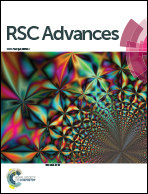New organic–inorganic hybrid material based on a poly(amic acid) oligomer: a promising opportunity to obtain microfluidic devices by a photolithographic process
Abstract
Miniaturized total analysis systems are becoming a powerful tool for analytical and bioanalytical applications. Biological and chemical sensors for health and environmental applications often require adaptable technologies. A flexible and low-cost process using a material with efficient mechanical and thermal properties is necessary. Organic–inorganic hybrid materials offer the advantages of the organic content and the inorganic matrix. In this study, a microfluidic sensor is fabricated on a new hybrid photosensitive material using an accurate and flexible process based on pulsed UV laser lithography. The material is based on poly(amic acid) (PAA) oligomer with lower molecular weight and lower cost, 1,3,5-tris[(2-vinyloxy)ethoxy]benzene (TVEB) as a crosslinking dissolution inhibitor, pre-hydrolysed 4-vinylether-phenyltriethoxysilane (VEPTES) as an organic–inorganic material, and a photoacid generator (PAG). A fine positive pattern is fabricated in a 3 μm thick film with laser writing using 125 μW energy. The synthesized hybrid material is characterized by nano indentation to analyze the force required to indent the coating and to predict the coating hardness and elastic modulus. Furthermore, thermogravimetric analysis (TGA) and differential scanning calorimetry (DSC) are used to evaluate its thermal stability. Scanning electron microscopy (SEM) is performed to verify the homogeneity of the material. These newly prepared photosensitive hybrid materials can open the way for potential applications in the fabrication of microfluidic devices.


 Please wait while we load your content...
Please wait while we load your content...